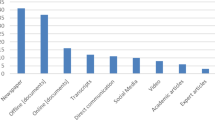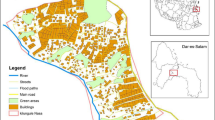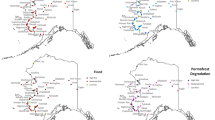Abstract
The notable success of an upstate New York community in resettling refugees raises the question of whether multiple waves of resettlement over a 15-year period have resulted in greater accommodation to refugees. Structured interviews based on transactional models of acculturation were used along with archival data to explore ecological factors supporting a host community’s behavioral flexibility and perseverance in response to the influx of refugees. Evidence suggests that socioeconomic climate, historical background/social norms, and the organizational structure of agencies involved in resettlement moderate successful inclusion of refugees into a host community in a bidirectional process.
Similar content being viewed by others
Notes
Two of the four participants were classified by the author as working in the area of Education even though their job could not be neatly classified in that way. These positions involved helping refugees learn to navigate various bureaucratic systems (not just educational systems), so their responses were aggregated in this category.
In three interviews, two participants were interviewed at the same time (one of these multiple participant interviews was conducted by both interviewers and two by the author). This yields a participant count of 35 despite an interview count of 32.
References
A brief history. (2004). Retrieved August 27, 2006 from http://mvrcr.org.
Attorney General’s settlement with two Utica hospitals guarantees enhanced language services for services for patients with limited English proficiency. (2003). Retrieved September 27, 2006 from http://www.oag.state.ny.us/press/2003/sep/sep22a_03.html.
Birman, D., Trickett, E., & Buchanan, R. M. (2005). A tale of two cities: Replication of a study on the acculturation and adaptation of immigrant adolescents from the Former Soviet Union in a different community context. American Journal of Community Psychology, 30(5), 585–607.
Birman, D., Trickett, E., & Vinokurov, A. (2002). Acculturation and adaptation of Soviet Jewish refugee adolescents: Predictors of adjustment across life domains. American Journal of Community Psychology, 35(1), 83–101.
Corbett, R. P. (January 7, 2005). Volunteers, honorees kick off annual event: America’s Greatest Heart Run & Walk. Utica Observer-Dispatch, A1.
CulturedMed. (n.d.). http://www.sunyit.edu/library/culturedmed.
Espenshade, T. J., & Hempstead, K. (1996). Contemporary American attitudes toward U. S. immigration. International Migration Review, 30(2), 535–570.
Esses, V. M., Dovidio, J. F., Jackson, L. M., & Armstrong, T. L. (2001). The immigration dilemma: The role of perceived group competition, ethnic prejudice, and national identity. Journal of Social Issues, 57(3), 389–412.
Gaertner, S. L., Mann, J. A., Dovidio, J. F., Murrell, A. J., & Pomare, M. (1990). How does cooperation reduce intergroup bias? Journal of Personality and Social Psychology, 59, 692–704.
Hagstrom, P. (2000). The fiscal impact of refugee resettlement in the Mohawk Valley. Clinton, NY: Hamilton College. Retrieved August 3, 2006 from http://www.hamilton.edu/levitt/pdfs/hagstrom_refugee.pdf.
Maslow, A. (1954). Motivation and personality. New York: Harper & Row.
Nadeau, P. (2003). The Somalis of Lewiston: Community impacts of rapid immigrant movement into a small, homogenous Maine city. Providence, RI: Brown University Center for the Study of Race and Ethnicity.
Owens-Manley, J., & Coughlan, R. (2001). Adaptation of refugees during cross-cultural transitions: Bosnian refugees in upstate New York. Clinton, NY: Hamilton College. Retrieved August 3, 2006 from http://www.hamilton.edu/levitt/pdfs/owens-manley_refugee.pdf.
Pettigrew, T. F., & Tropp, L. R. (2000). Does intergroup contact reduce prejudice? Recent meta-analytic findings. In S. Oskamp (Ed.), Reducing prejudice and discrimination. Mahwah, NJ: Lawrence Erlbaum Associates.
Phinney, J. S., Horenczyk, G., Liebkind, K., & Vedder, P. (2001). Ethnic identity, immigration, and well-being: An interactional perspective. Journal of Social Issues, 57(3), 493–510.
Pitarresi, J. (July 11, 2006). No limit on entries for 2007 race. Utica Observer-Dispatch, C1.
Radzilowski, J. (2005). Fecund newcomers or dying ethnics? A demographic history of Polish and Italian immigrants and their children in the USA. Retrieved October 9, 2006, from http://www.piastinstitute.org/pdf/newcomers.pdf.
Rappaport, J. (1977). Community psychology: Values, research, and action. New York: Holt, Rinehart, & Winston.
Strauss, A. L., & Corbin, J. (1990). Basics of qualitative research: Grounded theory procedures and techniques. Newbury Park, CA: Sage.
Trickett, E. J., Barone, C., & Watts, R. (2000). Contextual influences in mental health consultation: Toward an ecological perspective on radiating change. In J. Rappaport & E. Seidman (Eds.), Handbook of community psychology. New York: Kluwer/Plenum.
U.S. Bureau of Census. (2006). Retrieved September 29, 2006 from http://www.census.gov/popest/cities/tables/SUB-EST2005-05-36.csv.
U. S. Department of State, Bureau of Population, Refugees, and Migration. (2001). Operational guidance to resettlement agencies. Retrieved August 4, 2006 from http://www.state.gov/documents/organization/49009.pdf.
Waxman, P. (1998). Service provision and the needs of newly arrived refugees in Sydney, Australia: A descriptive analysis. International Migration Review, 32(3), 761–777.
Wilkinson, R. (2005). The town that loves refugees. Refugees, 1(138), 4–25.
Acknowledgements
I am indebted to my colleague and wife Mahadevi Ramakrishnan who was indispensable in both the data collection and editing of this work; we presented a version of this paper at the Sixth Annual Diversity Challenge Conference, Boston College, Boston, MA on October 20, 2006. Copies of the structured interview protocol are available by request. I am also grateful to the Mohawk Valley Resource Center for Refugees; the Utica City School District, Municipal Housing Authority, and Office of Urban and Economic Development; Oneida County Health Department and Department of Social Services; Faxton, St. Elizabeth’s, and St. Luke’s Hospitals; ConMed Corp., Empire Fiberglass Corp., Keymark Corp.; and the Greater Utica-Rome Board of Realtors for all their assistance. My appreciation is also extended to Meg Bond, Ruth Concepcion, Khanh Dinh, Anamaria Iosif-Ross, Mary Ann Janda, Steven Specht, Jo Ellen Vespo, Peter Vogelaar, Jennifer Yanowitz, and the three anonymous reviewers who provided insightful and useful feedback on an earlier version of this paper. Finally, I would like to thank John D. Coie for inspiring me to investigate the ecology of uncommon interactions while in graduate school.
Author information
Authors and Affiliations
Corresponding author
Appendix
Appendix
Template of Interview Protocol (Education/Employment/Health Care/Housing)
-
1.
How many years have you worked with refugees?
-
2.
What is the process for evaluating refugees’ [ESL/vocational assessment and training] needs upon their arrival (and afterwards)? [For Health Care: What is the process for providing refugees with health care upon their arrival (and afterwards)? (a) Are there special health care services for children? For women? For elders? (b) What kinds of mental health services are provided?] [For Housing: What is the process for housing refugees upon their arrival?]
-
3.
Are these services standard in resettling refugees (to your knowledge)? If not, then in what ways is the process different here? What led to these changes?
-
4.
What other agencies/offices do you collaborate with in order to provide [education/job training and employment/health care/housing and daily necessities] to refugees upon their arrival and afterwards?
-
5.
What role do volunteers play in the provision of these services? (Please provide examples without identifying individuals.)
-
6.
What is your impression of how the community has responded to refugees’ [education/employment/health care/housing] needs? (Please provide examples without identifying individuals.)
-
7.
In your opinion, what are the 2–3 most important ways that this community has in general shown support for refugees and accommodated their needs? (Please provide examples without identifying individuals.)
-
8.
In your opinion, what are the 2–3 most important ways that refugees have in general contributed to this community? (Please provide examples without identifying individuals.)
Rights and permissions
About this article
Cite this article
Scott Smith, R. The Case of a City Where 1 in 6 Residents is a Refugee: Ecological Factors and Host Community Adaptation in Successful Resettlement. Am J Community Psychol 42, 328–342 (2008). https://doi.org/10.1007/s10464-008-9208-6
Published:
Issue Date:
DOI: https://doi.org/10.1007/s10464-008-9208-6




